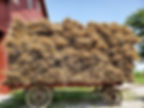Equipment in focus: A 1930s McCormick Deering Type E-M-4 grain binder at Carter Historic Farm (USA)
- Claus Kropp
- Jul 13, 2022
- 3 min read
Updated: Nov 15, 2022
In 2020, the Carter Historic Farm planted our first field crops, buckwheat and corn. That summer, just in time for our first harvest, we purchased a 1930s McCormick Deering Type E-M-4 grain binder. The binder was in operative condition, but we’ve still put a lot of work into it since then!

The E-M-4 is a tractor-pulled, PTO-powered binder with a 10’ cut, meaning that a tractor both pulls the binder and provides the power that makes it work, and it can cut a 10’ wide row of wheat at one time. The binder sticks out to the left of the tractor, where it cuts the wheat a few inches above the ground with a sickle bar mower, which operates by having serrated triangular knives cut the stalks against stationary fingers. At the same time the reel, up above, pushes against the wheat so that the cut stalks fall onto the conveyor belt. The main belt carries the wheat to the right end, behind the tractor, where it goes up a very short elevator, made of two more conveyor belts. At the top, a knotter ties the cut wheat into bundles.

The tied bundles then rest on the metal fingers of the bundle carrier until the person riding the machine lifts the foot pedal, which drops the fingers, dumping all the bundles currently being carried in the same pile. An attentive rider will drop the bundles to line up the piles so that they form even rows across the field to make the next step easier.


Helpers on foot then come and stand the bundles upright in a specific formation designed to aid in drying, called a shock. Wheat then sits out to ‘sweat’ for 10-14 days. Wheat brought in sooner may still contain too much moisture, and if it’s packed tightly on a wagon in a barn it may spontaneously combust!


After the sweating, workers come back out with wagons to pick up the shocks, which should be all conveniently in rows thanks to the precise bundle-dropping 2 weeks prior. From there the wheat is brought to a threshing machine, where it’s separated out into grain and stalks/straw. The wheat can be milled or otherwise processed for consumption, with some set aside to re-plant for the next year, and the straw can be baled for animal bedding or other use!


With our particular grain binder, the first step after purchasing it was to remove the many many decades of crusted on old grease. We then replaced several dozen grease zerks (fittings) and greased it up fresh! We slapped on some temporary reel bats, and then it was already time for our first buckwheat harvest!


2020 Buckwheat harvest at Carter Historic Farm
Since then, we have had time for research and more repairs. First, we researched the McCormick-Deering Paint Committee’s decisions – for decades, the committee decided colors for each and every part of every implement made by the company, and they kept detailed records. Finding the original decision about a specific implement may not be enough, however, if they changed their mind about a part in the years before your specific implement was built!

The next step was to fix the reel drive gear, replacing the large missing chunks in one of the gears, which gives us two possible speeds.



We straightened the reel axle, which had a mild bend in it.


We ordered new reel arms from an Amish company, for whom such equipment is still reasonably common. The wooden arms had been painted red immediately before packaging, and had dried together into one big red lump during shipping, so we had to carefully pry them apart before painting them to the correct color. The holes in the new arms were not in the exact same place as on the prior arms, which caused some problems in re-attaching the blue braces that help hold the reel together. We also replaced the reel bats, the boards that knock the stalks onto the conveyor belt.




Meanwhile, we ordered new canvasses for all the belts from another Amish craftsperson. Our belts and the ones currently used by the Amish, at least in his region, are slightly different, so we left our old ones with him to use as a guide for exactly what we needed.


With everything else in place, all there was to do was wait for the wheat to grow! When it did, we were ready!
2022 Wheat Harvest at Carter Historic Farm
Text and Pictures/Video:
Corinne Cordon Carter Historic Farm Website: Carter Historic Farm |Wood County Park District (wcparks.org)
